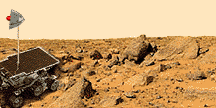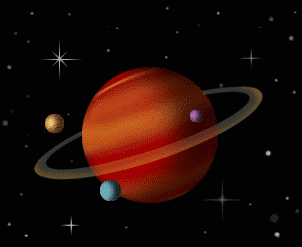 .....
.....
 .....
.....
ALWAYS use the videos if you missed a class AND for Exam reviews
*****************************************************
ALERT: TOPICS MAY NOT BE IN EXACT ORDER AS IN THE TEXTBOOK. GO BY THE LECTURE/VIDEOS FOR SEQUENCE.
*****************************************************
Reading Hints = Section 4.1 is MOST important section in this chapter and will be used the remainder of the semester.
4.2 - 4.3 is NOT needed now. We will come back to this section later in the semester. Sections 4.4 - 4.5 is optional.
Be able to define:
wavelength
visible light
ultraviolet radiation
infrared radiation
electromagnetic radiation
speed of light
photon
spectrum
OPTIONAL TELESCOPE INFO:
magnification
light-gathering power
refractor
reflector
eyepiece
primary lens
primary mirror
seeing
CCD
pixel
adaptive optics
Be able to:
- discuss the nature of electromagnetic radiation, and tell how that radiation transfers energy and information through interstellar space
- describe how Earth's atmosphere affects astronomical observations
- explain why it is important to make astronomical observations in many different regions of the electromagnetic spectrum
OPTIONAL TELESCOPE INFO:
- explain why very large telescopes are needed for most astronomical studies
- specify the advantages of reflecting telescopes for astronomical use
- discuss some of the current efforts to improve ground-based astronomy
- discuss the advantages and disadvantages of radio astronomy
Be able to list:
- list the names of the types of Electromagnetic radiation in order of wavelength
OPTIONAL TELESCOPE INFO:
- the purpose of the primary mirror or primary lens
- the purpose of the eyepiece
Be able to:
- describe the scale and structure of the solar system and list the
basic differences between the terrestrial and the Jovian planets .
Be able to define:
age of the Earth
seismic waves
mantle
crust
differentiation
plate tectonics
volcanism
magnetic field
conduction
convection
radiation
density
ozone
greenhouse effect
greenhouse gases
inner and outer cores
plate tectonics
spreading centers
subduction zones
continental collisions
hot spots
transform faults
Earth's atmosphere - composition
Greenhouse Effect
Be able to:
- discuss how Earth's atmosphere helps heat us as well as protect us.
- outline our current model of Earth's interior structure and describe
some experimental techniques used to establish this model
- summarize the evidence for continental drift and discuss the
physical processes that drive it
- describe the nature and origin of Earth's magnetosphere.
- describe the role of seismology
- explain the role of differentiation of the Earth
- summarize and compare the basic properties of the Earth
Be able to list:
-the major parts of the Earth from the crust inward
Be able to define:
natural satellite
synchronous rotation
tidal lock
terminator
limb
impact craters
mare
rays
impact hypothesis
Be able to:
- describe the consequences of gravitational interactions between
Earth and the Moon
- describe why we do not see the back side of the Moon.
- explain how dynamic events early in the Moon's history formed its major surface features
- discuss the formation and evolution of the Moon.
- summarize and compare the basic properties of the Moon
Be able to list:
- the differences between the maria and the highlands on the Moon
TEST 2 COVERS MATERIAL UP TO THIS POINT (and includding all material from Ch 1)
TEST 3 COVERS MATERIAL STARTING FROM HERE (but includes the Earth & Moon from Test 2)
Ch 7: Mercury, Venus, and Mars
Mercury:
Be able to define:
wrinkle ridges
Be able to:
- describe the general surface of Mercury
Venus:
Be able to define:
retrograde rotation
runaway greenhouse effect
Be able to:
- explain the relationships between surface features & planet size
- explain why some planets lack an atmosphere
- identify unique features on Venus
TEST 4 COVERS MATERIAL STARTING FROM HERE (but includes everything from Test 3)
Be able to define:
atmospheric properties of Uranus
internal structures of Uranus
Miranda
Be able to:
- describe the tilt of Uranus
- explain how Uranus was discovered
Reading Hints = read all of Ch 7.5
Reading Hints = read intro of Ch 7.6 but skip 7.6a and 7.6b
Class Lecture (Videos) Hints = Much more information provided in class lecture/videos on Pluto and the other KBO‚€™s (Kuiper Belt Objects)
Be able to define:
KBO's
Pluto
Mike Brown
Be able to:
- explain how the Pluto & Charon system is fundamentally different from
all other planet & moon systems.
- explain why Pluto is no longer a planet
- explain the importance of Eris
TEST 4 COVERS MATERIAL UP TO THIS POINT (and including the Terrertrial Planets from Test 3)
TEST 5 COVERS MATERIAL STARTING FROM HERE (but also includes all the planets from Tests 3-4)
Be able to:
- outline the process by which planets form as natural by-products of
star formation.
- explain the importance of cratering as a planetary process
- list the major facts that any theory of solar system formation must
explain and indicate how the leading theory accounts for them
Be able to:
- summarize the overall properties of the Sun.
- explain how energy travels from the solar core, through the interior, and out into space.
- discuss the nature of the Sun's magnetic field and its relationship to the various types of solar activity.
- name the Sun's layers and describe basic characteristics of each.
TEST 5 COVERS MATERIAL UP TO THIS POINT (and including ALL the planets from Tests 3-4)